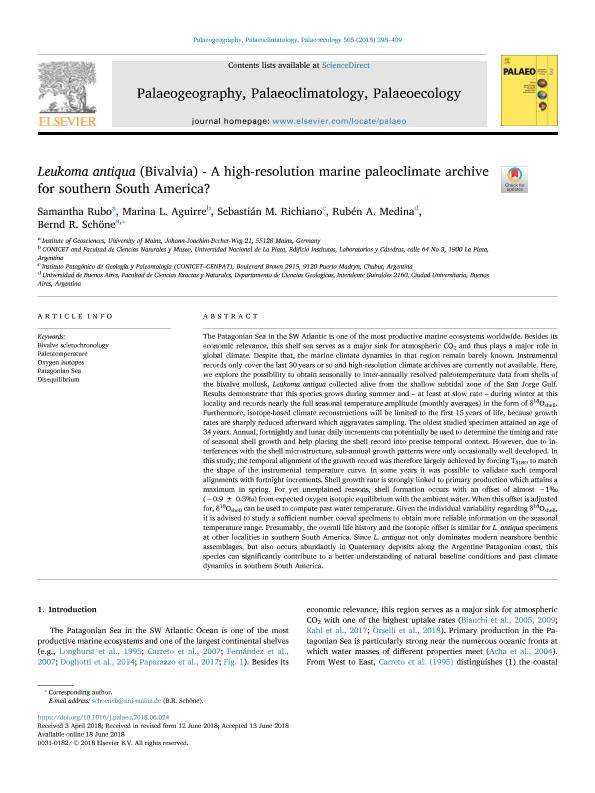Mostrar el registro sencillo del ítem
dc.contributor.author
Rubo, Samantha
dc.contributor.author
Aguirre, Marina Laura

dc.contributor.author
Richiano, Sebastián Miguel

dc.contributor.author
Medina, Rubén Alberto

dc.contributor.author
Schöne, Bernd R.
dc.date.available
2019-10-10T18:01:45Z
dc.date.issued
2018-09
dc.identifier.citation
Rubo, Samantha; Aguirre, Marina Laura; Richiano, Sebastián Miguel; Medina, Rubén Alberto; Schöne, Bernd R.; Leukoma antiqua (Bivalvia) - A high-resolution marine paleoclimate archive for southern South America?; Elsevier Science; Palaeogeography, Palaeoclimatology, Palaeoecology; 505; 9-2018; 398-409
dc.identifier.issn
0031-0182
dc.identifier.uri
http://hdl.handle.net/11336/85552
dc.description.abstract
The Patagonian Sea in the SW Atlantic is one of the most productive marine ecosystems worldwide. Besides its economic relevance, this shelf sea serves as a major sink for atmospheric CO2 and thus plays a major role in global climate. Despite that, the marine climate dynamics in that region remain barely known. Instrumental records only cover the last 30 years or so and high-resolution climate archives are currently not available. Here, we explore the possibility to obtain seasonally to inter-annually resolved paleotemperature data from shells of the bivalve mollusk, Leukoma antiqua collected alive from the shallow subtidal zone of the San Jorge Gulf. Results demonstrate that this species grows during summer and – at least at slow rate – during winter at this locality and records nearly the full seasonal temperature amplitude (monthly averages) in the form of δ18Oshell. Furthermore, isotope-based climate reconstructions will be limited to the first 15 years of life, because growth rates are sharply reduced afterward which aggravates sampling. The oldest studied specimen attained an age of 34 years. Annual, fortnightly and lunar daily increments can potentially be used to determine the timing and rate of seasonal shell growth and help placing the shell record into precise temporal context. However, due to interferences with the shell microstructure, sub-annual growth patterns were only occasionally well developed. In this study, the temporal alignment of the growth record was therefore largely achieved by forcing Tδ18O to match the shape of the instrumental temperature curve. In some years it was possible to validate such temporal alignments with fortnight increments. Shell growth rate is strongly linked to primary production which attains a maximum in spring. For yet unexplained reasons, shell formation occurs with an offset of almost −1‰ (−0.9 ± 0.3‰) from expected oxygen isotopic equilibrium with the ambient water. When this offset is adjusted for, δ18Oshell can be used to compute past water temperature. Given the individual variability regarding δ18Oshell, it is advised to study a sufficient number coeval specimens to obtain more reliable information on the seasonal temperature range. Presumably, the overall life history and the isotopic offset is similar for L. antiqua specimens at other localities in southern South America. Since L. antiqua not only dominates modern nearshore benthic assemblages, but also occurs abundantly in Quaternary deposits along the Argentine Patagonian coast, this species can significantly contribute to a better understanding of natural baseline conditions and past climate dynamics in southern South America.
dc.format
application/pdf
dc.language.iso
eng
dc.publisher
Elsevier Science

dc.rights
info:eu-repo/semantics/openAccess
dc.rights.uri
https://creativecommons.org/licenses/by-nc-nd/2.5/ar/
dc.subject
BIVALVE SCLEROCHRONOLOGY
dc.subject
DISEQUILIBRIUM
dc.subject
OXYGEN ISOTOPES
dc.subject
PALEOTEMPERATURE
dc.subject
PATAGONIAN SEA
dc.subject.classification
Geoquímica y Geofísica

dc.subject.classification
Ciencias de la Tierra y relacionadas con el Medio Ambiente

dc.subject.classification
CIENCIAS NATURALES Y EXACTAS

dc.title
Leukoma antiqua (Bivalvia) - A high-resolution marine paleoclimate archive for southern South America?
dc.type
info:eu-repo/semantics/article
dc.type
info:ar-repo/semantics/artículo
dc.type
info:eu-repo/semantics/publishedVersion
dc.date.updated
2019-10-10T13:18:15Z
dc.journal.volume
505
dc.journal.pagination
398-409
dc.journal.pais
Países Bajos

dc.journal.ciudad
Amsterdam
dc.description.fil
Fil: Rubo, Samantha. Johannes Gutenberg Universitat Mainz; Alemania
dc.description.fil
Fil: Aguirre, Marina Laura. Consejo Nacional de Investigaciones Científicas y Técnicas; Argentina. Universidad Nacional de La Plata. Facultad de Ciencias Naturales y Museo; Argentina
dc.description.fil
Fil: Richiano, Sebastián Miguel. Consejo Nacional de Investigaciones Científicas y Técnicas. Centro Científico Tecnológico Conicet - Centro Nacional Patagónico. Instituto Patagónico de Geología y Paleontología; Argentina
dc.description.fil
Fil: Medina, Rubén Alberto. Universidad de Buenos Aires. Facultad de Ciencias Exactas y Naturales. Departamento de Geología; Argentina
dc.description.fil
Fil: Schöne, Bernd R.. Johannes Gutenberg Universitat Mainz; Alemania
dc.journal.title
Palaeogeography, Palaeoclimatology, Palaeoecology

dc.relation.alternativeid
info:eu-repo/semantics/altIdentifier/doi/http://dx.doi.org/10.1016/j.palaeo.2018.06.024
dc.relation.alternativeid
info:eu-repo/semantics/altIdentifier/url/https://www.sciencedirect.com/science/article/pii/S0031018218303080?via%3Dihub
Archivos asociados
